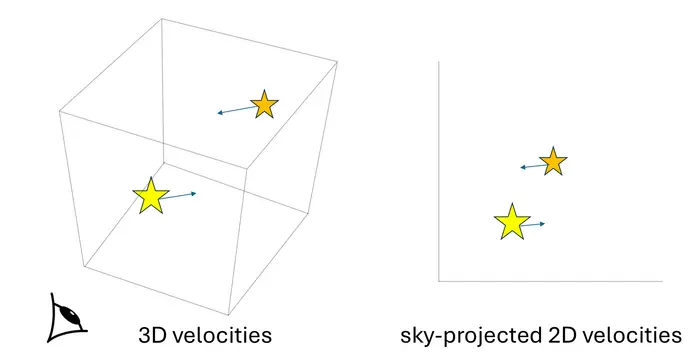Wide binary stars, intriguing celestial bodies separated by vast distances exceeding thousands of astronomical units, represent a fascinating domain of astrophysical research. These stellar pairs, with their expansive separations, provide unique opportunities for studying gravity in low-acceleration environments. Astrophysicist Kyu-Hyun Chae from Sejong University in Seoul, South Korea, has innovated a groundbreaking method for measuring gravitational forces through the full three-dimensional velocities of these binary systems. This pioneering approach marks a significant advancement over existing techniques, which have traditionally relied on only two-dimensional projections of star velocities.
The essence of Chae’s new methodology hinges on the application of the Bayes theorem, which facilitates a rigorous statistical framework for estimating the probability distribution of a key gravitational parameter. This parameter serves to measure the deviations of gravitational dynamics from the established Newtonian framework. By utilizing Markov Chain Monte Carlo simulations on the relative 3D velocities of binary star systems, Chae’s technique opens new avenues for comprehensively analyzing gravity’s role in the cosmos.
The implications of this methodology are profound, particularly considering that conventional methods are hamstrung by their reliance on velocities projected onto the sky plane. Chae articulates the limitations inherent in these traditional approaches, especially their difficulty in accurately factoring in uncertainties related to stellar masses. By overcoming these challenges, his revolutionary technique has the potential to redefine how researchers explore gravitational interactions in wide binary systems, which are typically observed only at specific phases of their orbital trajectories.
Chae’s method allows astrophysicists to glean more accurate insights into the complexities of stellar motions, as the long orbital periods of wide binaries mean that existing observations often capture only fleeting moments. This limitation greatly restricts the amount of information available for analysis. In contrast, Chae’s approach leverages the complete 3D velocity vector, including the vital radial velocity component, enabling researchers to derive a far more comprehensive understanding of gravity’s influence in low-acceleration realms.
For his initial application of this newly developed technique, Chae analyzed around 300 wide binaries with relative precision in their radial velocities. These stars were identified through the European Space Agency’s Gaia mission, specifically from its third data release. While the initial findings are somewhat constrained by the precision of Gaia’s reported radial velocities, the results produced using Chae’s method yield probability distributions of gravitational forces that align strikingly well with recent studies conducted both by Chae himself and independently by other research teams.
Notably, for wide binaries where the internal accelerations exceed approximately 10 nanometers per second squared, the inferred gravitational forces conform to Newtonian expectations. However, in scenarios involving lower internal accelerations—corresponding to separations exceeding about 2000 astronomical units—the inferred gravity appears to be 40 to 50 percent stronger than Newtonian predictions. Remarkably, this deviation has been calculated with a statistical significance of 4.2 sigma, implying that standard gravitational theory falls outside the 99.997 percent confidence interval, highlighting a compelling inconsistency.
The correlation between Chae’s findings and the predictions postulated by modified gravity theories, particularly within the framework known as Modified Newtonian Dynamics (MOND), is striking. Developed nearly four decades ago by Mordehai Milgrom, MOND theorizes that gravitational behavior deviates from standard dynamics in specific low-acceleration settings, a concept that Chae’s findings seem to underscore. The discovery of this pronounced deviation in wide binary systems not only advances our understanding of gravity but also invigorates ongoing debates regarding the nature of cosmic phenomena.
Experts in the field have expressed their enthusiastic support for Chae’s contributions. Xavier Hernandez, who pioneered tests of gravity using wide binaries in 2012, lauds Chae’s research for its rigorous Bayesian approach. Hernandez emphasizes that this innovative methodology effectively transitions from 2D projected velocities to true 3D velocities, achieving remarkable accuracy through a comprehensive use of available data. Furthermore, Pavel Kroupa, a respected professor in astrobiology, has commended Chae’s work for its impressive clarity and its potential to yield increasingly valuable results over time, particularly concerning discrepancies with Newtonian gravitation that align with expectations from Milgrom’s theories.
Chae’s collaborative efforts with fellow researchers continue as they gather precise radial velocity measurements from various observational facilities, including the GEMINI North Observatory and the Las Cumbres Observatory. This empirical foundation is complemented by ongoing speckle photometric studies to identify potential hidden companions within these binary systems. The dedication to refining this methodology and ensuring the purity of observed binaries is paramount for fully realizing the potential of Chae’s groundbreaking approach.
As new data becomes accessible, Chae anticipates that enhanced precision in measuring radial velocities will allow for clearer distinctions between Newtonian and MOND gravitational frameworks. He expects that forthcoming results will contribute to narrowing the theoretical possibilities regarding gravitational dynamics, offering new insights into the fundamental forces governing the universe. The implications of this work extend not only into astrophysics but also into the broader realm of theoretical physics, as it challenges existing paradigms and encourages a reevaluation of our understanding of gravity.
In light of the rapidly evolving landscape of astrophysical research, Chae’s findings signify a pivotal moment in our grasp of gravity. By applying innovative methodologies and leveraging cutting-edge data from missions like Gaia, researchers are poised to achieve new heights of understanding, potentially leading to breakthroughs that could reshape fundamental theories of gravity. As the study of wide binaries progresses, and with each new observation of these unique stellar pairs, the future holds the promise of revealing deeper truths about the cosmos, while further exploring the nuances that govern the gravitational tapestry woven across the universe.
Subject of Research: Wide Binary Star Systems
Article Title: Low-Acceleration Gravitational Anomaly from Bayesian 3D Modeling of Wide Binary Orbits: Methodology and Results with Gaia Data Release 3
News Publication Date: 27-May-2025
Web References: DOI
References: N/A
Image Credits: Kyu-Hyun Chae
Keywords
wide binary stars, gravity measurements, Bayesian inference, Newtonian dynamics, modified Newtonian dynamics (MOND), 3D velocities, astrophysics, Kyu-Hyun Chae, Gaia data, astronomical units.




